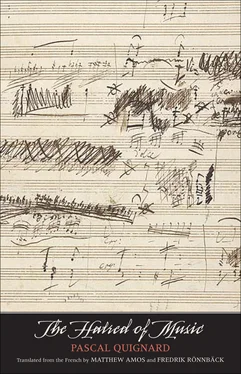Every tale, even before changing into the particular plot it stages, is in itself a lure-story (a fiction, a trap) to appease the souls of the exploited animals. All hunting with lures makes atonement through an offering that is nothing but a counterlure. In the same way that one must use songs and fasting to clean weapons infested by the spirits of the bodies that they have cast to the ground in blood and death.
Admitting the ruse that he inverts in the tale, the hunter coming from Kirkè’s abode exorcises the vengeance of the birds that the lure has placed in the song. The tale even exorcises the rope of the nets (that binds Ulysses). Even the birdlime (that plugs the ears of the hero’s companions).
Even the thorax ( kithara ) covered with strings that Ulysses becomes before the bird.

The word harmonia in Greek describes the way strings are attached in order to be tightened.
The first name for music in archaic Greece ( sophia ) referred to shipbuilding skills.

When Myron wanted to represent the god of music, he sculpted Marsyas, tied to a tree trunk, in the process of being skinned alive.

The peregrine falcon swoops down on the mallard.
The whistling of the nosedive, due to the speed of the fall, stuns the prey.

Harps, flutes, and drums come together in all music. Strings and fingers, wind and mouth, percussion of hands, and stamping of feet, all parts of the body dance under the influence.
The musical pieces of ancient Japan were always divided into three parts: jo, ha, kyou . The beginning was called “introduction,” the middle was called “tearing,” the end was called “presto.”
Penetration, tearing, very quickly.
The Japanese sonata form.

The shaman-sparrowhawk stands before the lark-spirit.
The shaman is a predator, a soul hunter: he sets traps, nooses, pitfalls, baits, birdlimes. He knows how to hold souls captive and coerce them with severed heads and bound hair. He knows one by one the roads (the songs) that lead to the souls. What the shaman calls road ( odos , an ode) is a half-recited and half-sung narration.

They are lures. The image of a fish thrown into the sea entices shoals of its congeners. Music is a call just as the image is a bait.
Even before the image became a bait: color was. Coating the walls with blood means dyeing the walls with the killed animal.
The first color is black (night, then the more absolute black in the darkness of the caves). The second is red.

Thunder is the call of the rainstorm.
The bullroarer 1 is the call of thunder.
The shaman’s drumming does not produce rain: the drummer hails the sound of thunder that in its turn calls the rainstorm.

Music is not a song specific to the species Homo . The song specific to human societies is their language. Music is an imitation of languages taught by prey at the time of the reproduction of the song of the prey during their reproduction.
Nature’s concerts. Music makes us moo, it makes us bray, it makes us trumpet.
It neighs.
It pulls from the belly of the shaman the absent animal that the body mimics and that the skin and the mask show.
Dance is an image. As painting is a song. Simulacra simulate. A rite repeats a metaphora (a voyage). Moving trucks in modern-day Greece still have the word METAPHORA on their sides. A myth is the danced image of the rite itself, which is expected to attract the world.

The shaman is a specialist in animal roars. The master of spirits can metamorphose into anyone or anything — although birds move the fastest and allow him to cross the sea or soar above the mountains. Birds are the most nomadic of nomads. The shaman is an accelerator of transport, of time, that is to say of metaphor, of metamorphosis. Finally he is the most acoustic of the acousticals.
His territory is the air delimited by songs.

1. Music summons to the place where it takes place, 2. it subjugates biological rhythms in dance, 3. in the circle of trance, makes the lowing that speaks in the shaman drop to the ground.
If the voice quavers, the body prances. Jumping is not leaping. Crawling is not sliding. Carp skip-up, tarantella, ball, and masquerade are originally the same thing. From where do we get wriggling, fidgeting, staggering? Lists indexing animal cries, in grammars, exercise an irresistible attraction, provoking endless competitions between children, which persist even among adults.
Ranting, yelling, bawling, barking, wailing, chirping, blabbering, hooting …
Ethnologists have inventoried musical techniques specifically used for intimidating tornadoes, whipping up hurricanes, quenching fire, stunning the wind, spreading panic in rains in order to measure their output by the drum’s rhythm, luring the flock to its trampling, bewitching the arrival of the wild beast in the body of the sorcerer, terrifying the moon, souls, and time into obedience.

In Saint-Genou one can still admire the sculpted Bird Ladies in the church. Cranes holding live rock in their claws. Their necks are tied into a knot, preventing any cry from leaving their throats. This cry is so dense that it kills any being that hears it, but it is so high-pitched that it vanishes into silence, unheard by the living, reminding them that the language of songs preceded the language of languages.

The men return from the underworld and roam the acoustic sea. All the living are under threat of being swallowed by the acoustic sea. Music lures them. Music is the call that lures them toward death.
That lures voices into a resemblance where they are lost.

In the estuary, the river no longer exhibits any of the delicacy of the source. Saving the source, this is my obsession. Saving the source of the river itself, which the source engenders, and which the river swallows by making it grow. We excavate Troy and peel an infinite onion. The great cities of ancient times have not returned to the forests that they cleared away. They will not return to this state. Civilizations, at best, give way to ruins. At worst, to irreversible deserts. I am part of what I have lost.
Sixth Treatise. LOUIS XI AND THE MUSICAL PIGS
The Abbé de Baigné was a musician. King Louis XI enjoyed his cantatas. So he would often have him come to his castle at Plessis. It was during the time of Gaguin’s ministry. The king would hold out his glass. He would ask Robert Gaguin to add to his wine a few drops of blood taken from his youngest subjects. One day, with Gaguin present, as the Abbé de Baigné spoke to the king about the sweetness that he thought unique to music, the sovereign asked him if he would be capable of creating a harmony with pigs.
Читать дальше













